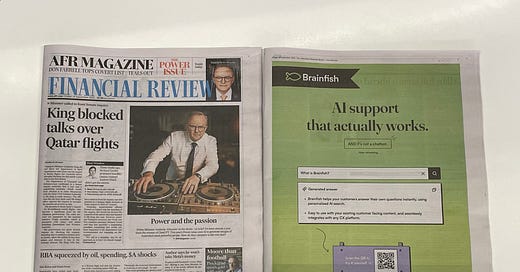Pẹlẹ o Mehketeers,
I was scrolling on LinkedIn as I so often do, and had to do a double take when I saw Daniel Kimber’s post about placing a full page print ad in the AFR for his AI startup, Brainfish.
Here’s the ad!
I, of course, jumped at the chance to interview him for Mehdeeka, as “does print work for SaaS/tech” is a question usually met with “good joke, of course not” and very few companies are actually testing it out.
Print is a whole other beast in terms of channel expertise, and it’s prohibitively expensive, so young startups just straight up can’t afford it most of the time.
Fun side fact: Today’s “hello” is from Yoruba, which got used a lot in my university linguistics exams because they assumed no one in the class spoke it. They also used Klingon until they found out someone in my class was a huge Trekkie.
Interview with Dan from Brainfish
Kayla: It's unusual for tech companies to use "traditional" marketing channels like print, what made you decide to give it a go?
Daniel: We’re thinking differently about marketing, as with everything we do. Brainfish is in a highly competitive space with a lot of bloated information about AI, and we want to make sure we stand out with very clear messaging about how we can help online businesses support customers more effectively.
K: Very few of us tech marketers have print experience, could you describe what the actual process was like, and how much it put you back? What do you wish you'd known before going through it?
D: Sure, it was quite an involved process, obviously you need to meet print specifications but there’s also more challenging specs around colour bleeding that we struggled with as most design applications these days don’t have strong customisation for print ink coverage. It felt almost a bit retro having to download Adobe Illustrator to change every single element’s colour coverages on a CMYK palette. Normally these ads with this sort of positioning cost upwards of $25k, fortunately we managed to get a decent deal here.
Definitely wish we’d known more about the colour profiling and file formatting as it was quite niche compared to what we’d typically be working with.
K: You mentioned you got positive ROI from it pretty quickly, what have the results been like?
D: Yes! We definitely ran the campaign with the goal of awareness and were super excited when we had some high quality meetings booked off the back of the ad. A few of those have converted already into customers so we’ve more than paid for the ad in both awareness and financial ROI - which in my mind is a perfect scenario for an ad of this kind.
K: Are there any other "traditional" channels you're interested in trying or think more tech companies should use?
D: Definitely we have a few in mind - we’re always looking for the most creative ways to get in front of people who need Brainfish. I’ll keep a lid on these for now but I’m sure you’ll see more of us in the coming months - especially if you work in an online business with a high volume of customer queries.
K: Are you using the more typical LinkedIn/Google/Meta ads platforms, and how do the numbers from the print ad compare?
D: Yes we run ads on Google and sometimes LinkedIn - we’ve found LinkedIn ads to be largely ineffective at this stage as you're paying per impression and not per click. Google ads have been great value for a company at our size. Meta we haven’t really explored as we don’t really believe that there’s many people using Meta platforms in the consideration stage of the funnel, and we are not putting a lot of focus on awareness at the moment (with the exception of the print ad ironically).
From a success rate perspective, the print ad is definitely harder to measure and has lower measurable ROI compared to online ads, but I’m confident we’ll continue to see residual benefits from it - such as the organic social traction we’ve received on the ad itself.
More things to know about print!
Print isn’t just for newspaper ads, if you’re doing events you’re likely working with vinyl banners, booths, paper brochures, merch, and all kinds of things that are technically printed! It’s good to know the specs so you can quality check work and avoid any costly mishaps.
Here are a few “good to know” bits and pieces for when you’re working with print:
Print images require 300 dpi (dots per inch, as in literal printer dots per square inch of paper), digital images are 72 dpi. Don’t send a digital image to be printed (even if it’s high res) because it’ll be pixelated. Physically print something before sending it off to a magazine/newspaper to make sure you get a good print quality.
You can’t scale up from 72 to 300 dpi - if you take your own headshots or team photos and you might one day get one of these printed in the AFR, keep the original RAW images or ask your photographer to send you both digital and print-ready files.
Similarly, when you download stock images, download both 72 and 300 dpi so you don’t have to pay for it again if you want to print one on a booth or physical materials. This can also be why your images are so huge, if you’ve downloaded a print file it’ll be SUPER big.
Alternatively, things like billboards are closer to 100 dpi. They look crisp from afar but up close they’re pretty fuzzy.
Print uses CMYK (cyan, magenta, yellow, black) colours, screens use RGB (red, green, blue) colours. If you send a graphic or file that was made in RGB and print it, the colours will come out looking weird, like a couple of shades off. Print files need to be made from the beginning in CMYK formats - newer design platforms like Canva and Figma are digital-first, which is why Dan mentioned Illustrator, which is equally for print and digital.
The difference for CMYK and RGB is confusing, but basically a screen has light coming through it, and that light coming through a pixel (where the pixel has red, green, and blue in it) changes the colour. Print on the other hand, starts with paper which absorbs light, and each colour is printed in a layer on top of it, so that’s taken into account with the CMYK model. Different types of paper will absorb ink in different ways.
Final fun fact: hair dye follows the colour principles of CMYK.
Join the Mehdeeka Focus Network
If you missed the bonus issue earlier this week, I shared an update on how the Focus Network beta went!
If you’ve got a piece of marketing work you would love a second set of eyes on, this is exactly what the Focus Network is for, and I’m now testing a V2 with an invite to anyone who’s interested!
Sessions are capped at 10 marketers + a moderator (me, for now) and work is handed round for each person to give feedback on, before receiving all the feedback your piece of work at the end of the session. It’s only 30 minutes to take as little time out of your day as possible, while maximising what you get out of it.
More details on the event page!
A levy of links
McDonald’s halloween ads (also in print!)
The Philadelphia Inquirer is running a campaign to appeal to Gen Z and younger milennials to consider subscribing to the newspaper. I saw a critique that this is a waste of time/money and instead of advertising they should change the editorial direction of the paper to focus on topics these demographics care about, but I disagree. It’s a local newspaper covering local issues - getting younger people interested and involved in local things is a tale as old as time.
‘We’ve officially moved on from retro-style mascots to “weird little guys”’
Cya next week!
Kayla








